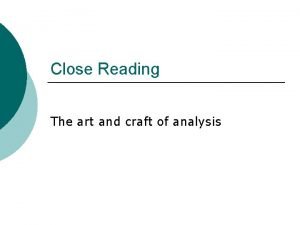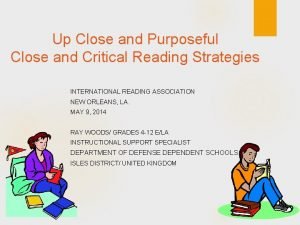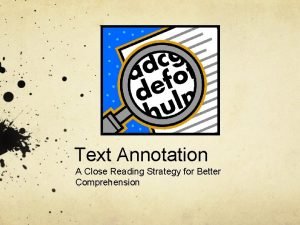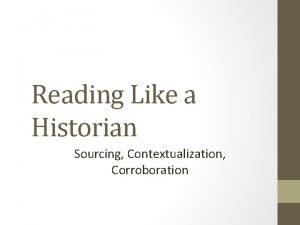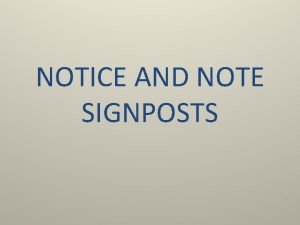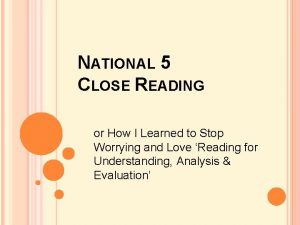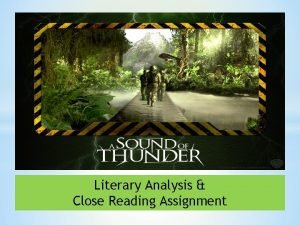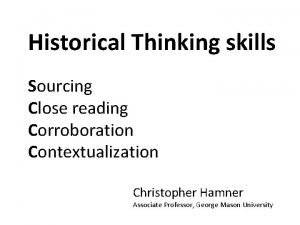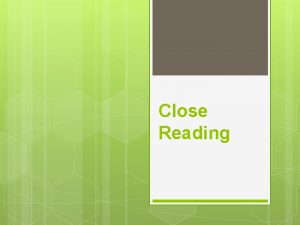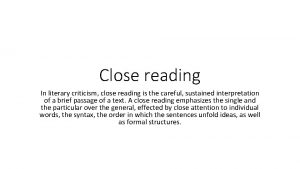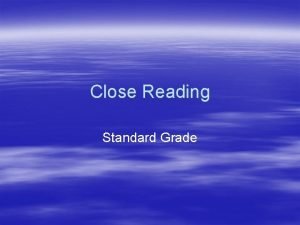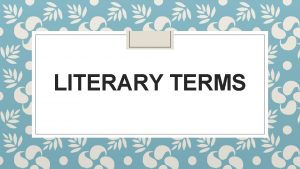Close Reading Close Reading An Overview Literary Analysis









- Slides: 9

Close Reading

Close Reading – An Overview Literary Analysis requires that one not only read the text, but look closely at what the author is saying as well as how the author is saying it. When close reading, it is important to look at the small details and understand how they work together in the piece to create meaning.

How to Read Closely When reading, look at passages that seem important in the text. Underline or highlight or take notes on passages that stand out. Things you might look for: ◦ Symbolism ◦ Repeated images, words or ideas ◦ Words or phrases that jump out as important ◦ Words or phrases that can be interpreted in more than one way ◦ Irony or ambiguity ◦ Passages you don’t understand ◦ Figurative language

How to Read Closely Before you look too closely at what you’ve marked, make sure you understand the basic plot and characters. ◦ Look at characters and their roles in the work. Try paraphrasing passages you don’t understand. Look for associations you make with words that the work challenges. ◦ An angel is normally associated with cleanliness and purity. ◦ Passages that emphasize dirtiness might be important.

How to Read Closely Look up the meanings of words! There may be a meaning that you didn’t think of before, or a word that may have had different meanings at different times in history. A good resource for looking up words is the Oxford English Dictionary (OED). ◦ The OED provides definitions of words relevant to specific time periods.

How to Read Closely Re-read passages you did not understand the first time. Never ignore anything that you don’t understand. Keep working at difficult passages until they make sense.

How to Read Closely– Now what? After reading and making note of important passages, try to find a unifying idea. First, ask what the elements seem to be saying. Any idea supported by the text is valid. There are no “crazy” or “stupid” ideas, unless there is no evidence from the text to support the claim. Don’t try to relate everything you found in the story. Use the parts that create one unifying idea. ◦ However, don’t ignore anything that contradicts this unifying idea. Remember to present and discuss any contradicting evidence you find.

How to Read Closely – Unifying Idea If you have trouble finding a unifying idea: The thesis (unifying idea) should point to something about the text that people might not otherwise have realized. If no one would argue your point, ask “So what? ” Try writing about ideas that interest you. ◦ By writing your ideas down you may begin to see connections you did not see before. ◦ Sometimes the answer to this question is thesis.

How to Read Closely – Utilizing Quotes Use everything from the text that works for your idea. Also, quote from the text. ◦ Show what details you found, and tell why they are important. Quotes support your argument, and you need to support every idea with evidence from the text. If there is no evidence, there is no argument.
 Close reading the art and craft of analysis
Close reading the art and craft of analysis While reading activities
While reading activities Chapter 1 overview of financial statement analysis
Chapter 1 overview of financial statement analysis Close and critical reading
Close and critical reading Annotation symbols for close reading
Annotation symbols for close reading Sourcing definition history
Sourcing definition history Signposts in reading
Signposts in reading National 5 close reading
National 5 close reading Close reading assignment
Close reading assignment Sourcing corroboration contextualization
Sourcing corroboration contextualization
